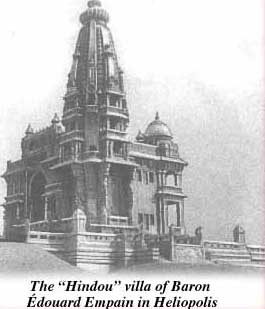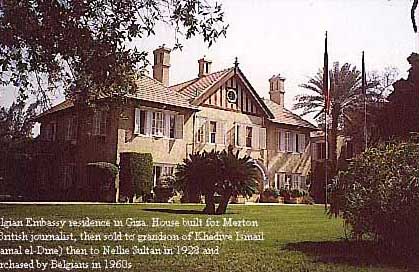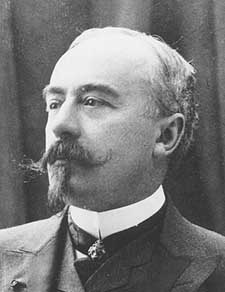by Samir Raafat
Egyptian Mail, May 13, 1995
 MENTION Belgians in Cairo and you'll automatically hear
the words 'tramways' and 'Heliopolis'. And by association with Heliopolis you
will hear 'Hindu folly' and 'Baron Empain'.
MENTION Belgians in Cairo and you'll automatically hear
the words 'tramways' and 'Heliopolis'. And by association with Heliopolis you
will hear 'Hindu folly' and 'Baron Empain'.
Heliopolis of course refers to the the city by the same name created in 1906-7 by Baron Edouard Empain. During the project's dream-up phase, the city-to-be was also known as The Oasis. At least this is how it was described in the 1906 prospectus put out by its Belgian developers who had meanwhile incorporated themselves into The Cairo Electric Railways & Heliopolis Oases Company. To be noted that the new company's share issue was oversubscribed even before the first stone was laid in the desert, nine kilometers north of Cairo.
In 1982 Robert Ilbert of the French Centre Nationale des Recherches Scientifiques (CNRS) published a scholarly description of this city entitled Heliopolis, Genese D'une Ville. It is an excellent description of Heliopolis, its layout and its architecture. Ten years later, on 22 September 1992, a two-month exhibition entitled 'Heliopolis, Un Reve Du Baron Empain' opened at the Centre du Monde Arabe in Paris commemorating almost 100 years of Empain presence in Egypt.
Hindu folly on the other hand refers to Empain's palace on the airport road (ex Avenue des Palais renamed Orouba Avenue reference to the rising Pan Arabism under Nasser). Designed by French architect Alexandre Marcel (1860-1928) and decorated by Georges-Louis Claude (1879-1963), the Palais Hindou was completed in 1911.
Almost a century later and Empain's zany alcazar is not without its Hindu palace buffs, a select group which includes amongst others Yvon Toussaint, former editor-in-chief of the leading French language evening paper in Brussels, Le Soir. He recently published a 470-page book entitled Les Barons Empains (editions Fayard, 1996).
Other self-declared buffs are Belgium Ambassadors Cardon de Lichtbuer and Gaston Van Duyes-Adam, as well as the former director of the Centre Culturel Francais in Cairo, Bernard Richard.
Since much has already been written on Baron Empain (1852-1929) the prodigal son of the village school teacher who became one of Europe's greatest 20th century colonialist entrepreneurs, the next few lines will tackle lesser known Belgians who also made it big in Egypt.
Like other foreign resident communities in the 19th and the first half of the 20th century, the few Belgians who came to Egypt played a disproportionately important role in Egypt's cultural, economic and industrial development. These were a small, tight-knit community that kept a relatively low profile. And despite their more numerous and vociferous Gallic cousins, they nevertheless had friends in high places.
For instance the Egyptian Gazette's 27 January 1915 announces that Sultan [Hussein Kamel] had "entertained several prominent members of the Belgian community to a luncheon at Abdine Palace the previous day. Guests included Fritz de Lancker, Leon Rolin, Maitre Leon Carton de Wiart, Maitre George Merzbach Bey, Henri Naus Bey, Ernest Jaspar, Edmond Van Grootven, Charles de Royer and, George and Alfred Eid." Two years later, in September 1917, all of the above plus four other Belgians (Victor Pescher, J. Dubrucq, Maurice van Regemorter, N. Leysbeth) were decorated by the Sultan.
With one exception the above men were either businessmen, lawyers or entrepreneurs. Absent at the meeting since he was by now a WW1 general in the Belgian army, was Baron Edouard Empain. It was no secret that the Sultan was an admirer of the general-baron's enterprising spirit and as though to prove it, had moved his family into the forty-room pseudo-oriental palazzo situated diagonally opposite the Hindu Palace. By so doing Sultan Hussein was the first Egyptian ruler to live in Helioplolis the next one being the incumbent President Hosni Mubarak.
Against a colonial backdrop where Egypt was a virtual British crown territory, it was uphill for many of the Belgians who had invested in Egypt. Denied a board seat on the powerful British-run National Bank of Egypt, Baron Empain's successors in Egypt decided to launch a bank of their own. Although the Banque Belge et Internationale en Egypte was constituted on 30 January 1929 with a declared capital of one million Egyptian pounds, in reality it had replaced the older Banque Belge pour l'Etranger, which itself had taken over the portfolio of Banque Sino-Belge's Egyptian branch. The earlier colonial bank's Cairo office was located at Kenissah al-Gedidah Street with sister branches in London, Peking (now Beijing), Shanghai and Tientsin.
But why a Belgian bank in Egypt? The answer to this question lies in the on-going competition at the time between two of the world's most powerful trading and industrial groups. On one side of the English Channel you had London responsible for most of the global map being colored pink. On the other you had the Franco-Belgian conglomerates of which the Empain Group was an important element. The competition between these titans was mirrored in the Egyptian market by the battle of wills between Baron Empain's business concerns and those of his British nemesis, Sir Ernest Cassel, the chief backer of the Anglo-Judeo financial, commercial and industrial institutions in Egypt. For almost two decades, these two men controlled directly or indirectly a significant portion of Egypt's commercial activities.
Although the highly visible Banque Belge directors Pierre and Emanuel Bonvoisin, Louis van Damme, Jacques, Ellsworth Lambiotte and Robert Halet were relative latecomers on the scene, they were also the first to leave Egypt. Their precipitated departure was brought on by the assassination Patrice Lumumba's in the former Belgian Congo in February 1961. As though on queue, the Belgian Embassy in Cairo was ransacked and torched and all Belgian property seized.
When Belgian citizens were asked to leave on February 27 of that year, a unique chapter in Egypto-Belgian relations ended in bitter recriminations. Africa was in the process of de-colonization and the Arab World was closing ranks with its Third World brethren. No more White Man colonialism!
But it was precisely during the latter part of colonialism that foreign capital, foreign entrepreneurs and foreign labor found their way into Egypt. All the right economic indicators had been put in place, from an accommodating Khedive towing the British line, to a regime of Capitulations and Mixed Courts protecting foreign investors from local laws and taxes. It was open season for opportunity-seeking foreigners.
Yet even before Britain occupied Egypt, Belgian consuls during the reign of Mohammed Ali (d. 1849) had established economic footholds in the port city of Alexandria. One of their first priorities was hiring a local dragoman or Mr. Fix-it who could facilitate the consul's entree into the Khedivial entourage for it was there that big contracts and lucrative commissions were handed out.
The dragoman (translator) was an indispensable member in any foreign legation or diplomatic agency. In the Arabic-speaking Middle East dragomans were usually Greeks, Italians or local Christians with a basic European education.
In the case of the Belgians, a Syrian dragoman was hired by the name of Hanna Eid (afterwards Gallicized to Jean). He spoke acceptable French courtesy of one of the many missionary schools that spread French culture and ideals across the Levant. Eid would eventually found a mini-dragoman dynasty and with time was well connected to an ever-expanding network of diligent Syrian migrants who spread themselves across the Delta's cash-crop gathering centers.
Much later in the 19th century, the Belgians hitched a much more gratifying ride this time with Armenian businessman-politician Boghos Nubar Pasha, son of Egypt's five-time Prime Minister Nubar Nubarian, confidant to two viceroys and three khedives.
In return for, and in proportion to, their services the Eids and the Nubars were amply compensated in money and in kind. With time, these local beneficiaries brought into the game their respective cliques --the Khouris, Bicharas, Karams, Baharis (Syrians); and Artins, Arakels (Armenians), all of whom became Belgian proteges and later claimed that country's citizenship. They were invariably referred to by their benefactors as les faux Belges.
As Eids and Nubars looked after Belgian affairs along with their own commercial interests, more Belgians arrived on scene. Together they created a handful of Belgian enterprises and joint ventures that would have an inversely proportional impact on Egypt's commercial development and infrastructure structure.
In the agricultural sector the most important companies set up with Belgian participation were the Gharbieh Land Co., the Kafr al-Dawar Co., the Agri-Industrial Co. and the Anglo-Belgian Company of Egypt.
In the industrial sector one must evoke the two breweries (the Stella brand name became internationally known). The Crown Brewery of Alexandria and the Societe Anonyme Bieres Bomonti et Pyramides in Cairo.
In the financial sector there was the Mortgage Company of Egypt, and the Societe Generale Egyptienne pour l'Agriculture et le Commerce.
And there was of-course the all-powerful Banque Belge.
But it was in urban development that Belgians scored highest, particularly in the building and transport sectors. Belgian companies dealing in these sectors were the Societe; Belge-Egyptienne de l'Ezbekieh, the Cairo Suburban Buildings Land Co. Ltd., The Koubbeh Gardens Co., and the Compagnie Immobiliere d'Egypte. There were also the construction giants of M. Padova, Leon Rolin & Co. inventors of the compressol system, and the Societe des Travaux Publics du Caire.
Most important among the Belgian transport companies was Empain's Cairo Electric Railways and Heliopolis Oases Company Limited followed by the Chemins de Fer de la Basse Egypte, the Fayoum Light Railways, the Tramways du Caire, the Tramways d'Alexandrie, Wagons Lits & Grands Express Europeens, and the Menzaleh Canal and Navigation Co.
There were also those enterprising individuals who penetrated the inner sanctum of the Khedivial court. The Carton de Wiart brothers are a good example. While one brother -- Rene-- was an officer in the Khedivial household, the other, Maitre Leon Carton de Wiart, was a well-known court magistrate. The de Wiarts benefited from a direct pipeline to King Leopold in Brussels through their cousin Edmond Carton de Wiart. This fortuitous occurrence helped the De Wiart brothers to circumvent the often long and expensive middleman route. They were also instrumental in laying the groundwork for the King of the Belgian's visit to Egypt in 1930.

Belgian Embassy residence off Pyramids Avenue. Home to British journalist
Merton, Gamaleldine Mahmoud Sirry (grandson of Khedive Ismail), Na'ela (Nellie)
Sultan before becoming Belgian property
Just as the de Wiart brothers were about to retire from the local scene, the Eeman family: George, Ernest and Jacques, had come of professional age. The last two were learned judges at the Mixed Courts to whom the legal jargon was deja vu since Egypt's Constitution of 1923 was modeled on its Belgium counterpart. Another sharp legal mind that made it to the top of Egypt's judiciary was Maurice de Wee, one of the last president's of the Mixed Courts which wrapped up its activities in 1949, when Egypt's judicature became the only law of the land.
Somewhere between the de Wiart's and the end of abolition of Capitulations was the adept jurist Maurice Jacquet, King Fouad's trusted legal counsel. In 1937 Jacquet was among the Egyptian delegation to the Montreux Conference which negotiated the end of the Mixed Courts regime. Later during WW2 Jacquet (seconded by Emile Jacobs) headed the 'rebel' Belgian Union in Egypt. This was the darkest hour of the small Belgian community in Egypt which had spilt into two opposing factions, those loyal to King King Leopold now reduced to a nominal ruler of occupied Belgium, and those like Jacquet who stood firmly behind Britain and its allies.
It was also during WW2 that several of Egypt's Belgians lost their lives including the sons of entrepreneur L. Rolin and industrialist Henri Naus.

Although the Belgian captains and kings of Egyptian industry looked at Edouard Empain (photo) as the honorary doyen of Egypt's affluent Belgian community, it was to Henri Naus Bey (1875-1938), to whom they turned for advice.
Naus Bey and Anne Etty, his Javanese-raised wife, came to Egypt at the turn of the century. With the assistance of his two proteges Albert Ceyssens and Raoul Roche, Naus successfully reorganized the Egyptian Sugar Company which had suffered a final coup de grace when its chairman Ernest Cronier committed suicide in Paris after loosing much of the company's assets at the Paris Bourse. Under the Naus administration the Sucreries flourished becoming the standard banner for all other agro-industrial projects. Although the Societe des Sucreries et Rafineries d'Egypte started out as a Franco-Jewish consortium (Cronier-Suares), for several decades after it was run exclusively by Belgians.
Over the years, Naus developed a close relationship with Egypt's King Fouad and it was at the latter's prompting that he sat on numerous business and charity boards. It was also Henri Naus who created the Assistance Publique (ambulance) of Egypt in 1910. He was its first Vice-president and later its president. Likewise, Naus was also treasurer of the Red Crescent of Egypt.
In 1922 Naus was nominated the first President of the Egyptian Federation of Industries, a very prestigious and influential position at the time.
Belgians also contributed to Egypt's tourist industry as evidenced by Joe Renson, Marcel Herman and Paul Delcave. A whole generation of Egypt's international café society are in the debt of these famous hoteliers who took turns at the helm of the Hotels Company of Egypt and helped launch the famous Semiramis Hotel's Grill Room and its legendary Roof Garden. Both outlets were immortalized in many books dealing with Egypt's belle epoque. It was that same Belgian clique that operated the inimitable Heliopolis Palace Hotel built in the early teens of this century by Belgian architect Ernest Jaspar. During President Mubarak's administration the hotel was turned into a presidential palace from where images and soundbites are flashed around the world during epic summit meetings and conferences.
While the list of movers and shakers of the above mentioned companies is far too long, yet one can mention the players connected in some direct or indirect way to the Empain Conglomerate. Apart from the Empain family: Edouard, Jean, Louis and Francois, there were the Jacobs of Antwerp: Jules, Alfred, Frederic, Max and Emile (insurance and real estate); the de Lanckers: Fritz and Robert; and Leon Van der Hecht and L. La Hererre (tramways, transport and electricity).
There were also the construction giants Rolins: Ernest, Leon, Jacques and Daniel; and Francois Rom. There was Janig H. Chaker who symbolized Wagons Lits and its affiliate hotels in Egypt and the Middle East. Most of these persons had come as ordinary citizens armed with their arts and crafts and a will to succeed. When they left, it was either with the ennobled titles of Chevalier and Baron, or with the Egyptian Order of the Nile. In some cases both. These decorations were proud testimonials for the worthy services rendered to both their host nation, Egypt, and to their mother country, Belgium.
The Belgians who had come to Egypt late 19th century or early 20th gave a new meaning to the words international cooperation. They lived well in Egypt and gave generously in return. This is clearly in evidence whenever one visits their palatial homes, most of which were subsequently purchased by embassies or taken over as high profile government institutions.
While the early Eids -- Jean, George and Alfred -- were Belgium's honorary consuls in Egypt, decades later, their descendants returned as senior Belgian diplomats or as Catholic missionaries. One of the former, Guy Eid, lost his life in the line of duty on 1 March 1973, when as Belgium's charge d'affaires in the Sudan, he and American Ambassador Cleo Noel were fatally shot by Black September militants during a Saudi Embassy reception in Khartoum. Earlier Eids died fighting for Belgium during WW1 and WW2.
As events changed the face of the Middle East the Boghos Nubar palace which stands a few meters south of the Hindu palace was sold in the 1970s to a Kuwaiti real estate consortium along with its sitting military tenants. Nubar Pasha's descendants have meanwhile integrated into Belgian and European society marrying into its haute Bourgeoisie. All that remains of Egypt's vrai and faux Belges are nostalgic memories. The only reality today linking us to the Belgians of Egypt is the abandoned Hindu Palace whose precarious fate is still undecided.
For old photos of Heliopolis click here
For
detailed 1913 survey map of Heliopolis click here
To
learn about the Heliopolis Palace Hotel (Presidential Palace) click here
To
read about the Baron Empain Palace click here
To
learn about Koubbeh Gardens click here